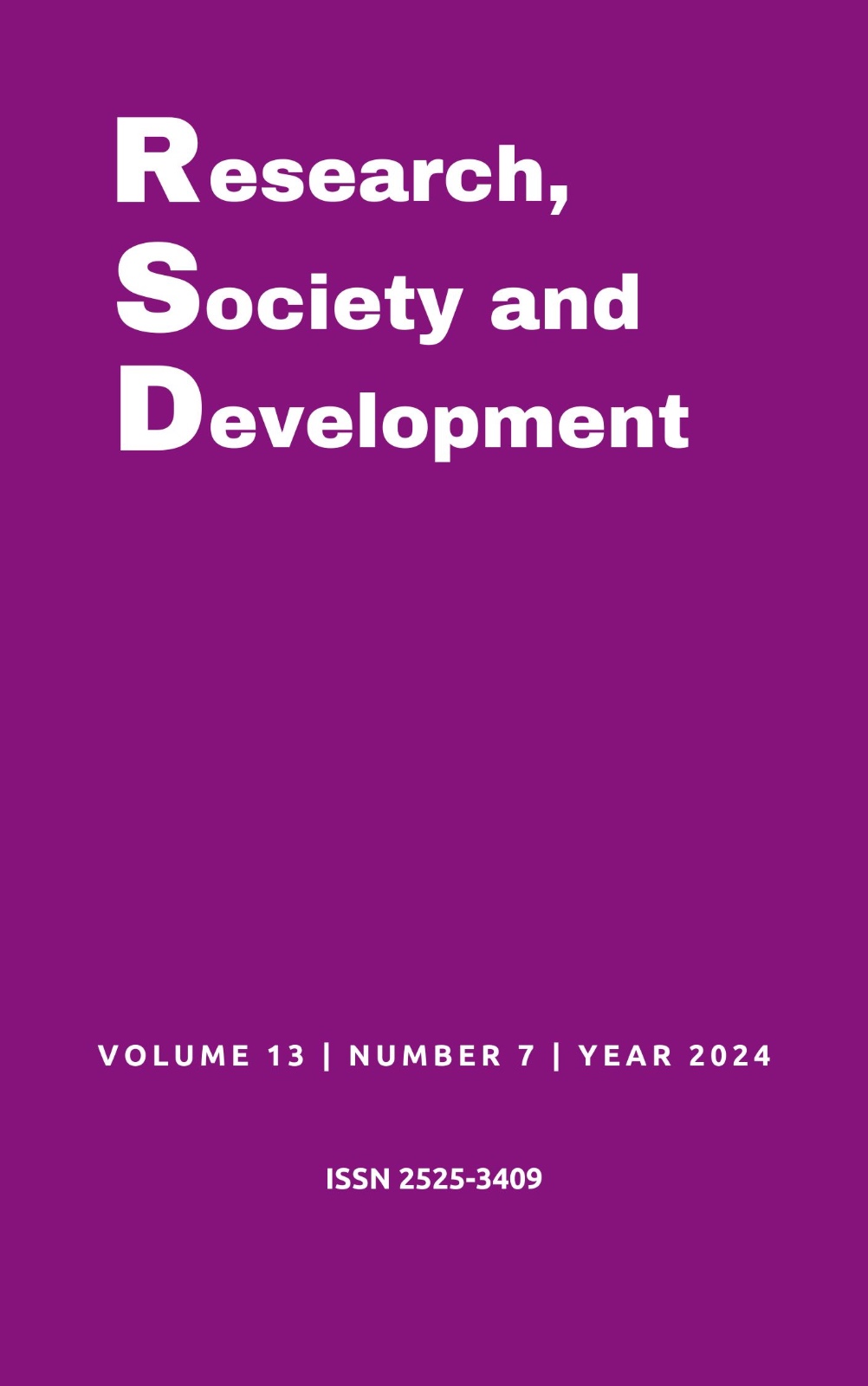Alginato versus silicone de adição: Qual o melhor material para prótese parcial removível?
DOI:
https://doi.org/10.33448/rsd-v13i7.46223Palavras-chave:
Prótese parcial removível, Silicones, Alginatos.Resumo
Objetivo: O objetivo deste estudo foi fazer um artigo de revisão de literatura narrativa, abordando dois tipos de materiais diferentes: silicone e alginato, com objetivo de ver qual é o melhor material para compor uma prótese parcial removível. Metodologia: As buscas foram realizadas na PUBMED Central, Web of Science, BVS/BIREME, CAPES brasileira, Scielo e utilizando o portal Google Academy. Foram adquiridos um total de 24 artigos que abordam sobre os benefícios e malefícios do uso de silicone e alginato nas próteses parciais removíveis, além de suas diferenças. Realizamos consultas de periódicos e livros, visando obter mais informações confiáveis sobre o tema. Tendo em vista realizar uma revisão de literatura, a visão de Mattos (2015) foi utilizada para estruturar o artigo. Resultados: Ao decorrer do estudo, foi visto que o silicone de adição é amplamente considerado o melhor material devido à sua alta precisão, excelente capacidade de reprodução de detalhes e superior estabilidade dimensional, entretanto o alginato é mais econômico e fácil de usar, é mais adequado para impressões preliminares e situações onde a precisão extrema não é essencial.
Referências
Abrita, J. C. T., Fuller, J. B., Cucci, A. L. M., Giampaolo, E. T., & Leonardi, P. (1989). Alteração dimensional linear de moldes de hidrocolóide irreversível para prótese parcial removível. Revista de Odontologia da UNESP, 18, 265-272.
Anusavice, K. J. (2003). Phillips' Science of Dental Materials. (11th ed.). Saunders.
Carr, A. B., & Brown, D. T. (2011). McCracken's removable partial prosthodontics. (12th ed.). Mosby.
Chiarello de Mattos, M. G., Tiossi, R., Lapria Faria, A. C., Silveira Rodrigues, R. C., & Ribeiro, R. F. (2006). Moldagem em prótese parcial removível: Modelos de estudo, de trabalho e funcional. Recuperado de https://www.researchgate.net/profile/Rodrigo-Tiossi/publication/237064166
Craig, R. G., Powers, J. M., & Wataha, J. C. (2000). Dental Materials: Properties and Manipulation. (8th ed.). Mosby.
Craig, R. G., & Powers, J. M. (2002). Materiais Dentários Restauradores. (12th ed.). Artmed.
Eckert, S. E., & Lammie, G. A. (1996). Accuracy of elastomeric impression materials with varied impression techniques. The International Journal of Prosthodontics, 9(2), 113-121.
Ewoldsen, N., & Sundh, A. (1991). The accuracy of impressions: A study of precision of impression materials and techniques in the clinical situation. Swedish Dental Journal. Supplement, 77, 1-39.
Garcia, P. P., Goiato, M. C., Dos Santos, D. M., Haddad, M. F., & Pesqueira, A. A. (2023). Evaluation of the accuracy of alginates and addition silicones for the production of partial removable dental prostheses. Materials Research Express, 10(3), 035401. https://doi.org/10.1088/2053-1591/ac6920
Hyde, T. P., Craddock, H. L., & Gray, J. C. (2011). Removable partial dentures: A practitioner's manual. Blackwell Publishing.
Johnson, G. H., & Craig, R. G. (2011). Accuracy of Four Types of Elastomeric Impression Materials Compared with Digital Scans. Journal of Prosthetic Dentistry.
Khasanov, R., & Mansurov, A. (2022). Comparative analysis of alginates and addition silicones in the manufacture of removable dentures. Stomatological Review, 1(15), 12-18. https://doi.org/10.17116/stomat20221150112
McCabe, J. F., & Walls, A. W. G. (2008). Applied dental materials. (9th ed.). Blackwell Publishing.
Mattos, P. C. (2015). Tipos de revisão de literatura. Unesp, 1-9. https://www.fca.unesp.br/Home/Biblioteca/tipos-de-evisao-de-literatura.pdf
Nogueira, S. S., Antoniazzi, R. P., & Bortoluzzi, E. A. (2019). Silicone facial prostheses: A systematic review of the literature. Journal of Prosthetic Dentistry, 122(6), 585-594. https://doi.org/10.1016/j.prosdent.2018.11.005
Phoenix, R. D., Cagna, D. R., DeFreest, C. F., & Stewart, K. L. (2012). Stewart's clinical removable partial prosthodontics. (4th ed.). Quintessence Publishing.
Powers, J. M., & Sakaguchi, R. L. (2012). Craig's Restorative Dental Materials. (13th ed.). Mosby.
Preiskel, H. W. (2011). Precision attachment prostheses: Theory and practice. Quintessence Publishing.
Puri, A., Khanna, A., & Dixit, S. (2015). Comparative evaluation of the accuracy of impression materials used for indirect restorations: A review of literature. Journal of Clinical and Diagnostic Research, 9(6), ZE04-ZE09.
Rosenstiel, S. F., Land, M. F., & Fujimoto, J. (2006). Contemporary fixed prosthodontics. (4th ed.). Mosby.
Rother, E. T. (2007). Revisão sistemática x revisão narrativa. Acta paul. enferm., 20(2). https://doi.org/10.1590/S0103-21002007000200001
Skinner, E. W., & Pomes, C. E. (1946). Dimensional stability of alginate impression materials. Journal of the American Dental Association, 33, 1253-1260.
Walker, M. P., & Petrie, C. S. (2005). Moisture Effect on Dimensional Accuracy and Detail Reproduction of Elastomeric Impressions. Journal of Prosthetic Dentistry.
Winkler, S., & Imberman, M. (2002). Essentials of complete denture prosthodontics. Blackwell Munksgaard.
Downloads
Publicado
Edição
Seção
Licença
Copyright (c) 2024 Pedro Guimarães Sampaio Trajano dos Santos; Maria Clara Domingues da Silva; Lucas Cavalcanti de Lima Félix; Maria Eduarda Maldonado Coimbra do Nascimento; Irene Alcantara Eiras Silva ; Eudoro de Queiroz Marques Filho; Ailton Coelho de Ataíde Filho

Este trabalho está licenciado sob uma licença Creative Commons Attribution 4.0 International License.
Autores que publicam nesta revista concordam com os seguintes termos:
1) Autores mantém os direitos autorais e concedem à revista o direito de primeira publicação, com o trabalho simultaneamente licenciado sob a Licença Creative Commons Attribution que permite o compartilhamento do trabalho com reconhecimento da autoria e publicação inicial nesta revista.
2) Autores têm autorização para assumir contratos adicionais separadamente, para distribuição não-exclusiva da versão do trabalho publicada nesta revista (ex.: publicar em repositório institucional ou como capítulo de livro), com reconhecimento de autoria e publicação inicial nesta revista.
3) Autores têm permissão e são estimulados a publicar e distribuir seu trabalho online (ex.: em repositórios institucionais ou na sua página pessoal) a qualquer ponto antes ou durante o processo editorial, já que isso pode gerar alterações produtivas, bem como aumentar o impacto e a citação do trabalho publicado.


